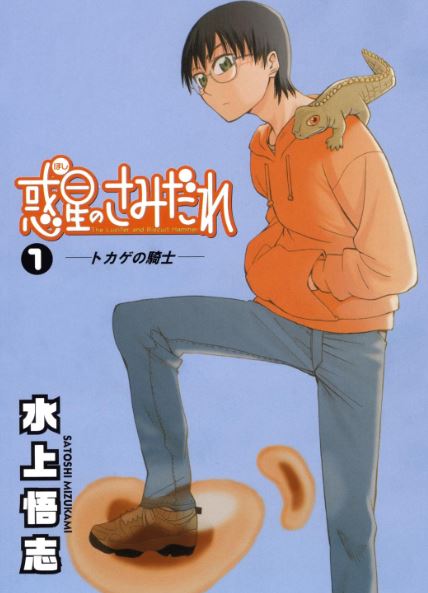
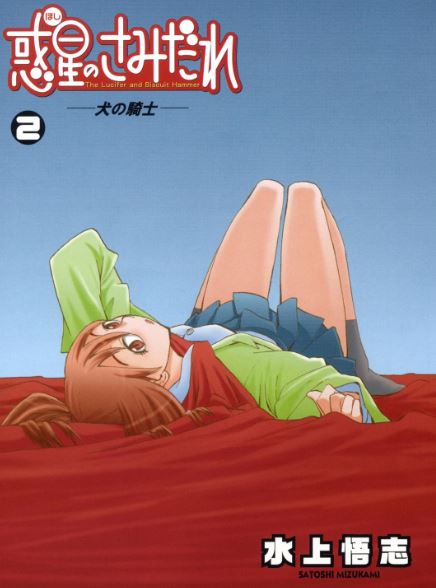
A new week, a new Monday, a new Manga Review! Hello, dear sir/ma’am, it’s extremely gracious of you to take time out from your busy schedule to come check out this post. I am eternally grateful. Now, with the formalities all out of the way, let’s jump into this week’s review!
Today, we will be talking about Satoshi Mizukami’s seminal work, Hoshi no Samidare or The Lucifer and the Biscuit Hammer and how it parodies genre stereotypes while still being a highly thrilling and heartfelt story at its core. Let’s break it down.
THE PREMISE:
A talking lizard seeks a boy’s help to protect the princess, Lucifer, and save the world from the evil witch who intends to destroy earth by crushing it to bits using a hammer with a biscuit-shaped head.
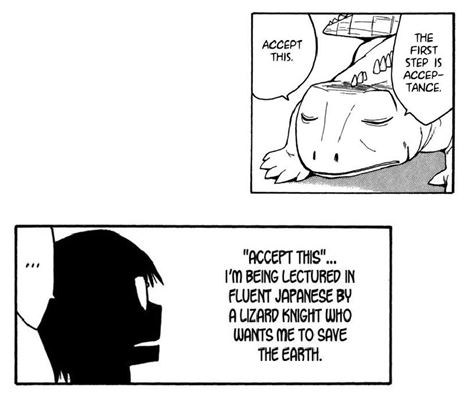
WHY YOU SHOULD READ IT:
Yeah, I know, even with talking lizards and princesses called Lucifer, Hoshi no Samidare sounds like another one of those ‘Save the World’ types of tales where it seems as if our protagonist is somehow the only one chosen to be the knight in shining armor (quite literally in this story). And to be fair, it is that. But it’s also so much more. Hoshi no Samidare is essentially a parody of shounen stereotypes which pokes fun at the clichés of the genre and the storytelling beats which always hold such stories back from turning into something truly great. But for all its parodies and straying from traditional genre norms, Hoshi no Samidare does take its core plot very seriously. Even though the plot sounds like something an adolescent would come up if given nothing but the title ‘The Lucifer and The Biscuit Hammer’ to work with, the story’s unflinching adherence to that premise gives it a sense of authenticity. It’s because of this very reason that the reader never takes any plot point, no matter how absurd, too lightly. And that’s another one of the many charms of Hoshi no Samidare: its ability to make the most absurd of things sound like run-of-the-mill narrative developments because of which, after a certain point, the reader just goes along with the absolute insanity of it all.
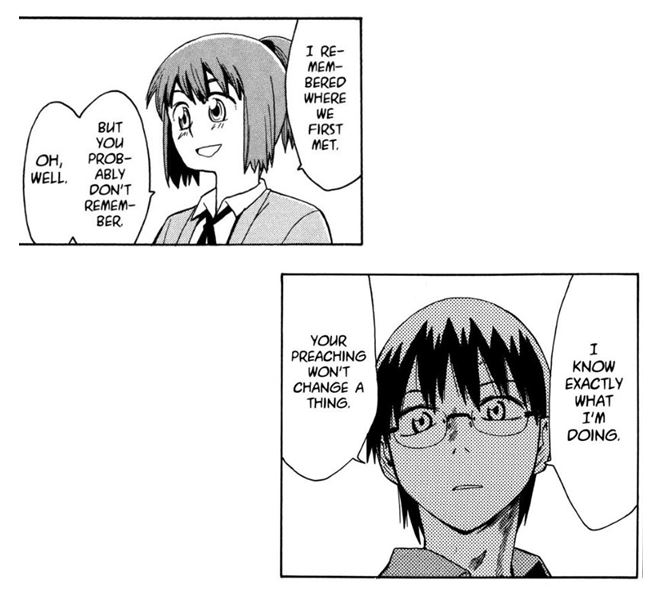
This is the kind of story where your enjoyment out of it relies on a few key factors; the most important of these being the choice of protagonist. And in Amamiya Yuuhi, we are presented with one of the best shounen protagonists I have come across in a long long time. Yuuhi is the kind of person who doesn’t care for anything. He just wants to be left alone and live the life of a regular high-school boy, checking out women’s underwear every chance he gets. He doesn’t want to be the hero and wants no part in a fight that doesn’t concern him. In fact, he believes that he’s so weak that in any fight, he’ll mostly end up being nothing but dead-weight. He is as far from OP as a protagonist can be and has no real desires. If given a choice to have any one thing he wished for, he’d want another cup of his usual ramen noodles or to be waken up at 6 the next morning. He doesn’t really know what he wants. So, the question bears asking: why should we root for him? And the answer is pretty simple. Because like us, he doesn’t really know what he wants. That’s what makes him relatable. Watching him grow from a person with no ambitions to someone who wants to protect the things he cares for and let go of the chains of his past which hold him back (again, quite literally) is what makes this his journey so very rewarding.
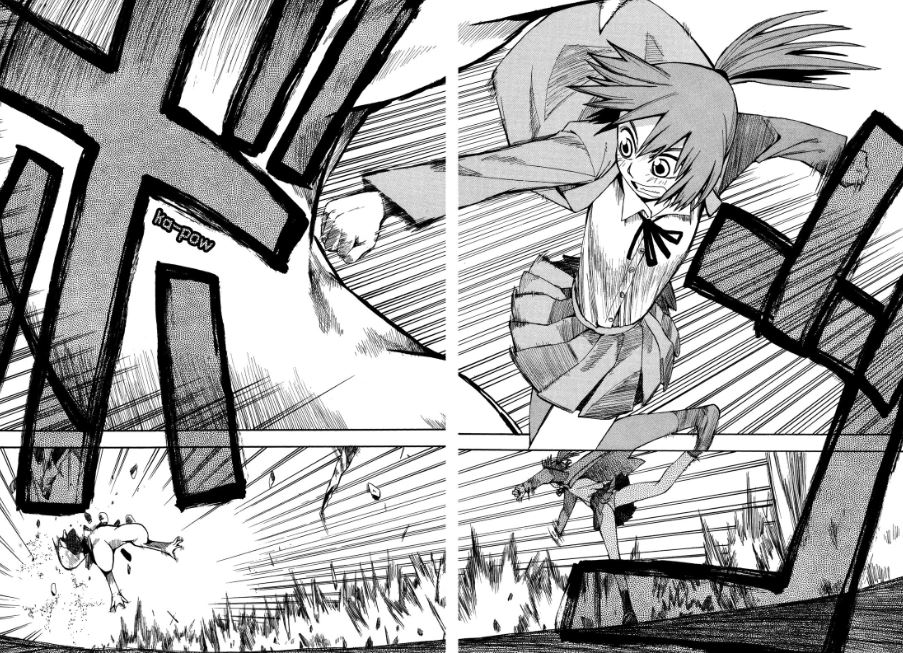
As for the plot itself, the absurd nature of it all tricks us into this false sense of belief that we know where this story is headed and that we’ve seen all this done before. But in reality, the narrative hides some jaw-dropping reveals in plain sight and is also imbued with a surprising amount of depth. Though, the thing that surprised me the most about this manga is the stellar art. It is of consistent quality throughout but when in the moments of hype such as some climactic fights, the art takes a huge step-up with the artist utilizing joint manga panels and great use of shading techniques to portray the weight and impact of some blows. A+ for that! Finally, one last positive note that I wanted to make was for the ending: it is spectacular. I would have never predicted that a story about a boy with an underwear fetish and multiple talking animals would end up making me tear up. But the poignant and cathartic resolution of it all might just make you feel that way too.
In short, if coming-of-age tales with a refreshingly unique protagonist and a quirky plot progression and plenty of humor sprinkled throughout is something you are interested in, go and pick up Hoshi no Samidare. You are surely in for a real fun time!
WHY YOU SHOULDN’T READ IT:
Honestly, the only possible negative I can think of is the humor. It’s ever present and not to everyone’s tastes. A lot of the laughs are derived through slapstick means and as with all kinds of comedy that relies on such means, the jokes don’t always land. Apart from that, if you are vehemently against reading all and any kinds of shounen, even Hoshi no Samidare won’t be able to change your mind. So, do bear that in mind before picking this up.
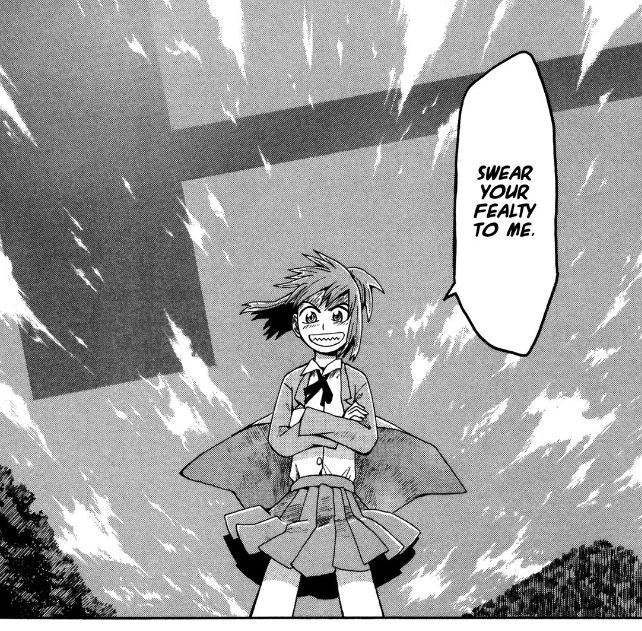
FINAL THOUGHTS:
This was my first Mizukami manga and yes, I have seen the Planet With anime but that was an original production which must have been held back by studio restrictions. Hoshi no Samidare on the other hand, is an unadulterated amalgamation of Mizukami’s talents and a no-holds-barred display of his creativity. If you’ve been meaning to pick it up or have never heard about him, I’d urge you to read it either way. Just like me, you might end up coming out of it as a fan.
SCORE: 9.4/10
☆—————-☆—————-☆—————-☆—————-☆
With that, we conclude this week’s coverage. Next week, I will be reviewing the manga chosen through the votes of last week’s poll, Inio Asano’s Nijigahara Holograph. To have your favorite manga get reviewed the week after, be sure to vote in this week’s poll here!
And feel free to leave the titles of any manga you think needs more attention down in the comments below and I will be sure to include it in later polls.
As always, thank you for reading and see ya next Monday! ^^

Yeah this manga absolutely owns. The author really is one of the best at closing his story, a skill that many writers don’t have (not to imply the rest of the story isn’t awesome, it absolutely is).
Now I might be totally wrong, but for me out of his three masterpieces (so far) this is the most mature I’d say. Spirit circle is almost a fantasy while Sengoku Youkou seems like the most pure shounen. Tbh I can’t decide which one is the best out of them and I recommend them to everyone. Each is an absolute joy to read.
Yes, I totally agree. The whole story was interesting by itself but that ending was like the sweetest cherry-on-top that made the time invested so very worth it.
I do intend to pick up Spirit Circle sometime soon and that has a reputation of arguably being better than Hoshi no Samidare, so I am really looking to forward to it!
To this day I don’t understand why this and other Satoshi Mizukami works haven’t gotten anime adaptions. I thought Planet With would change that but sadly not.
Anyway in regards to this mangaka there is the big three that you should read. First is this, second is Spirit Circle which quite a number of people consider to be even better than Biscuit Hammer and third is Sengoku Youko, which is likely the weakest of the three due to having a very slow start but once it gets going it has moments that hit just as hard as the other two.
From what I have noticed, his stories never adopt a set story structure and he sort of plays around with the viewer/reader’s expectations of where everything is headed. Planet With had like 4 endings within its 12 episode run. And Biscuit Hammer too never goes along the usual shounen route. I haven’t read Spirit Circle but I expect it to do the same. Maybe anime studios aren’t willing to take a risk on something which is that far off the mainstream.
Although admirable for its villain writing, I couldn’t stand Planet with for the style of condensed pacing, couldn’t connect with it and generally got alienated by its super robot action scenes.
As for biscuit hammer, even though it is a satire of shounen, it was comically lost on me, couldn’t get into any of the characters and I wasn’t gelling with the art style.
In general I dislike many deconstructions as they require some actual care about whats being deconstructed to work and if I end up really liking something that’s being deconstructed, its probably going to risk annoying me too.
As it stands I actually liked mad sorcerer man in biscuit hammer but nothing else.
Oppositely, Spirit circles second half floored me, especially when it went into its antagonist and when it adopted a certain genre in one later arc.
Yes yes. I do intend to get around to Spirit Circle soon. And you praising it so much, even though you aren’t a fan of the author’s other works, gives me all the more reason to do so